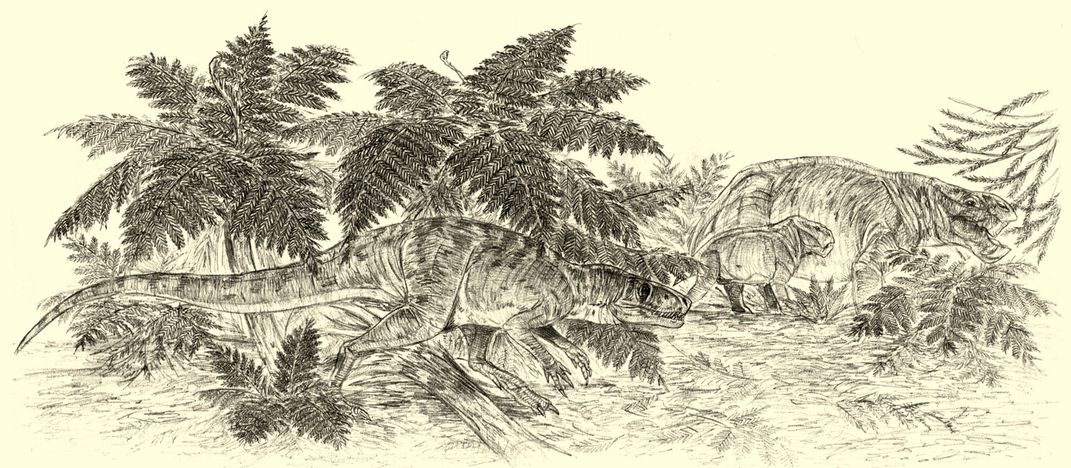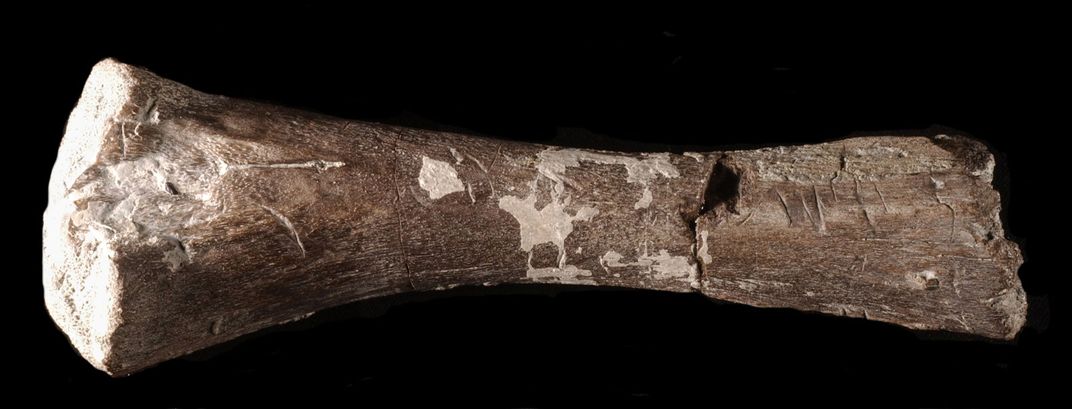Prehistoric Crocodile Cousin Crushed the Bones of Its Prey Long Before T. Rex
Fossilized feces filled with bone reveal the feeding habits of an ancient predator
:focal(1009x780:1010x781)/https://tf-cmsv2-smithsonianmag-media.s3.amazonaws.com/filer/4d/f7/4df771db-c853-479f-ac38-b9ebc569b023/smok.jpg)
Tyrannosaurus rex was the biggest bone-crusher of all time, pulverizing its prey with a spectacularly powerful bite. But the “tyrant king” didn’t pioneer the technique of crunching on bones. Over 130 million years before T. rex walked the Earth, a relative of today’s crocodiles smashed through bones with robust teeth and pulverizing jaws.
Uncovered in 2007 at a Polish site called Lisowice, fossils of the 205-million-year-old carnivore, named Smok wawelski, were first described by Uppsala University paleontologist Grzegorz Niedźwiedzki and colleagues in 2012. Despite the Triassic reptile’s kinship in a broad family that includes today’s alligators and crocodiles, Smok (which means “dragon” in Polish) was a very different kind of predator. The animal roughly resembled the giant, flesh-eating dinosaurs that would evolve millions of years later, and the chomper’s table scraps have revealed that Smok was adept at breaking carcasses down into splinters.
That Smok was a carnivore was immediately apparent from the reptile’s skeleton. The recurved, serrated teeth set in its jaws were adapted for latching into prey. But the extreme extent to which Smok consumed bone comes from new lines of evidence. Fossilized feces and petrified vomit attributed to the carnivore, recently documented by Niedźwiedzki and coauthors in Scientific Reports, indicate that Smok didn’t just chew the fat.

Matching fossil feces—called coprolites by experts—to a particular animal is often difficult. The fossils don’t come with signatures. But, in this case, the preserved droppings' size, contents and location all point to Smok. “It was the only big predator in the ecosystem,” Niedźwiedzki says, noting that there are no isolated teeth, footprints or traces of another competing carnivore.
The ability to look inside coprolites without damaging them allowed researchers crack the case of how this carnivore ate. “We used to have to cut up coprolites in order to get a look at their contents,” University of Tennessee paleontologist Stephanie Drumheller-Horton says, but now CT-scanning technology offers a way to peek inside without destroying the fossils.
The coprolites found at the Smok fossil site in Poland contained bits of teeth from the ancient crocodile relative. “Because this animal would have replaced teeth throughout its lifetime, accidentally swallowing shed or broken crowns was probably fairly common,” Drumheller-Horton says.
Smok didn’t just eat bone incidentally, though. The sheer volume of bone inside the reptile’s feces indicates that Smok was purposefully consuming bone, and the way the pieces were broken provides some clues of how the animal fed. Instead of swallowing bones whole—as some modern crocodiles and birds do—Smok broke down the skeletons of its prey. “This was done through repeated biting,” Niedźwiedzki says, adding that bones of other animals from the same site in Poland show repeated bites made by Smok.

The petrified vomit may have something to say about the life of Smok, too. Preserved throw up pellets, or regurgitalites, are rare in the fossil record. In some cases, they indicate that a predator consumed too much hard-to-digest material, like bone, and so a pellet is thrown up to make room for more. But there are other reasons why an animal like Smok might expel bone.
“Alligators and crocodiles will throw up if they are stressed after a meal,” Drumheller-Horton says. “They will also regurgitate food if the temperature drops.” This induced vomiting helps prevent food from rotting in the stomach if digestion slows from stress or metabolic changes. While it’s impossible to know exactly why Smok heaved up the bone pellets that researchers study today, Drumheller-Horton notes that there are several reasons why such an animal might jettison excess foodstuffs.
Smok was apparently so similar to T. rex in feeding behavior that petrified poop from both carnivores contains roughly the same proportion of mashed-up bone. The similarity is striking, considering Smok isn’t the only non-dinosaur to anticipate the anatomy or behavior of the “terrible lizards” that would evolve millions of years later. A mysterious Triassic creature called Triopticus had a similar dome to dinosaurs called pachycephalosaurs. Another crocodile relative called Effigia looks quite a bit like the “ostrich mimic” dinosaurs known as ornithomimosaurs. And a horned Triassic reptile pioneered a look that would later be adopted by horned dinosaurs like Triceratops.
“It almost appears that the Triassic was a period of evolutionary experimentation,” Niedźwiedzki says. Ecosystems with complex food webs were thriving, and paleontologists are only just beginning to document the oddities that evolved during this time. In the Triassic, dinosaurs were small and meek, not yet the dominant beasts of our imaginations, while crocodile relatives and other strange reptiles ruled the planet. If an extinction event hadn’t turned the tables and wiped out creatures like Smok, the age of reptiles could have completely prevented the rise and reign of the dinosaurs.
/https://tf-cmsv2-smithsonianmag-media.s3.amazonaws.com/accounts/headshot/RileyBlack.png)
/https://tf-cmsv2-smithsonianmag-media.s3.amazonaws.com/accounts/headshot/RileyBlack.png)